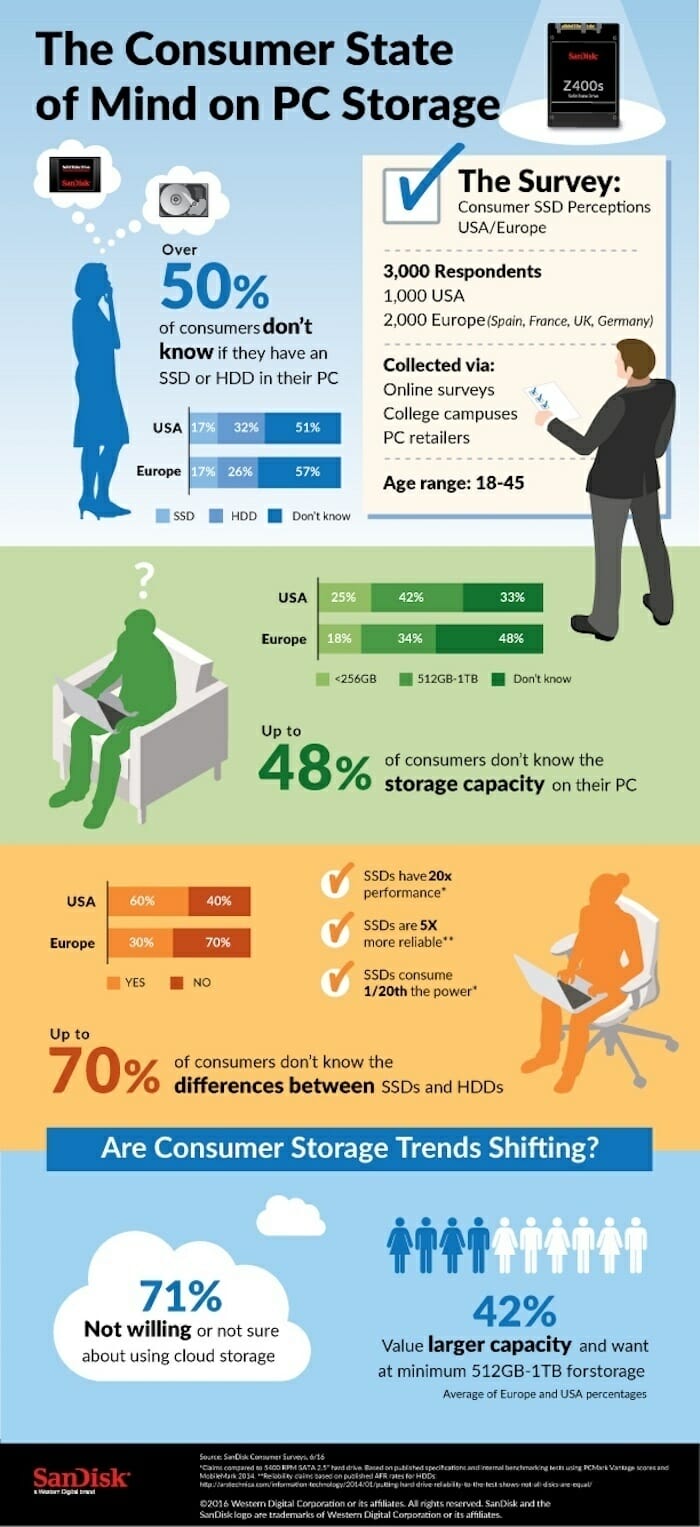SanDisk Survey: The Consumer State of Mind on SSDs
Back in January of 2005, I purchased my first-ever external hard drive to store music and movie files. It was a 100GB drive that I figured would be the first and last drive that I’d ever. 10 years ago, the average consumer could not conceptualize how much space a 650MB movie file would take up on a 40, 60, or 100GB hard drive. In the time before high-definition/4K video and downloaded virtual reality video games, it truly was a megabyte-dominated world. The word terabyte hadn’t entered into our vocabulary yet.
Today, you can get a 4TB external drive from WD that’s portable enough to drop in a purse or bag, or if you want smaller and faster, you can get something like the 480GB SanDisk Extreme 500, compact enough to fit in your pocket and as a bonus, it’s water resistant to protect your files from the elements.
With all these options on the market today, it’s easy to understand why consumers find difficulty in picking devices that are right for their needs. If you’re one of these consumers, I’ve included the table below for reference with a break down of storage points and how many typical work/home files will hold relative to capacity:
So the question remains, how much storage do people really need to get by in today’s content-rich digital world and does type of storage even matter? Does the average consumer even know what the differences are between hard disk and solid state drives? Are we ready for the shift to the cloud or do people still want and trust local storage more?
That’s what we set to find out in a survey we conducted in the U.S., Spain, Germany, France and the UK. We polled 3,000 PC users at universities, retailers, and on the good ole’ world wide web to see exactly how much people knew about the storage that was in their PC and here is what we learned.
What we learned from the results was that people may not be putting much thought into their actual storage needs or have a clear understanding of how storage impacts performance and the user experience.
- Over 50% don’t know what kind of storage they have
- Up to 48% don’t know the storage capacity on their systems
- Up to 70% don’t know the difference between SSDs and HDDs
- 71% still are not ready to move to the cloud, yet they want a higher range of capacity
This really comes as no surprise. Consumers have been conditioned to think that bigger is always better and that all storage is created equal, but if you’re transferring large files, accessing and using multiple programs at the same time, or editing photos or movies, you’ll want solid state performance with fast sequential read and write speeds. If you’re hoarding 2-hour movies from grandpa’s 80th birthday celebration, you’ll want a traditional capacity-centric hard drive. As much as we’d like to think that everything is moving to the cloud, while this may be true on the enterprise side, consumers are still very wary considering security breaches with personal information being exposed are still a common occurrence. The results from the survey also tell us that local, high capacity storage is still the safe bet when it comes to storing personal files.
When it comes to the PC buying experience, instead of utilizing the traditional model of having prospective buyers think about what options they want on their PC (DRAM, CPU, storage, etc.), retailers should adopt a configurator model that suggests different PC options based on users’ needs. It could be as simple as walking into the computing section at your local blue shirt retailer and answering a handful of questions on a tablet:
- Is a fast and responsive PC experience important to you?
- Are you editing movie or video files, or dealing with any high-intensive applications or games?
- Do you plan to use your PC for casual, everyday use for web browsing and productivity like spreadsheets and word processing?
- Do you plan to store a large number of files on your PC?
- Is a light and thin PC important to you?
- What is your price range?
In return, the configurator relays different PC options that are best suited for the consumer’s lifestyle. This way, someone with zero knowledge of processing power, caching, or RPM can still buy a PC that’s right for them. In the tech world, we sometimes forget that the people that use our products and the ones that could benefit most from them, don’t actually understand them. They just want products that will make their lives easier, and ultimately our goal should be to make the buying process easier for them.






